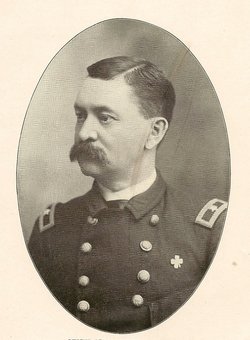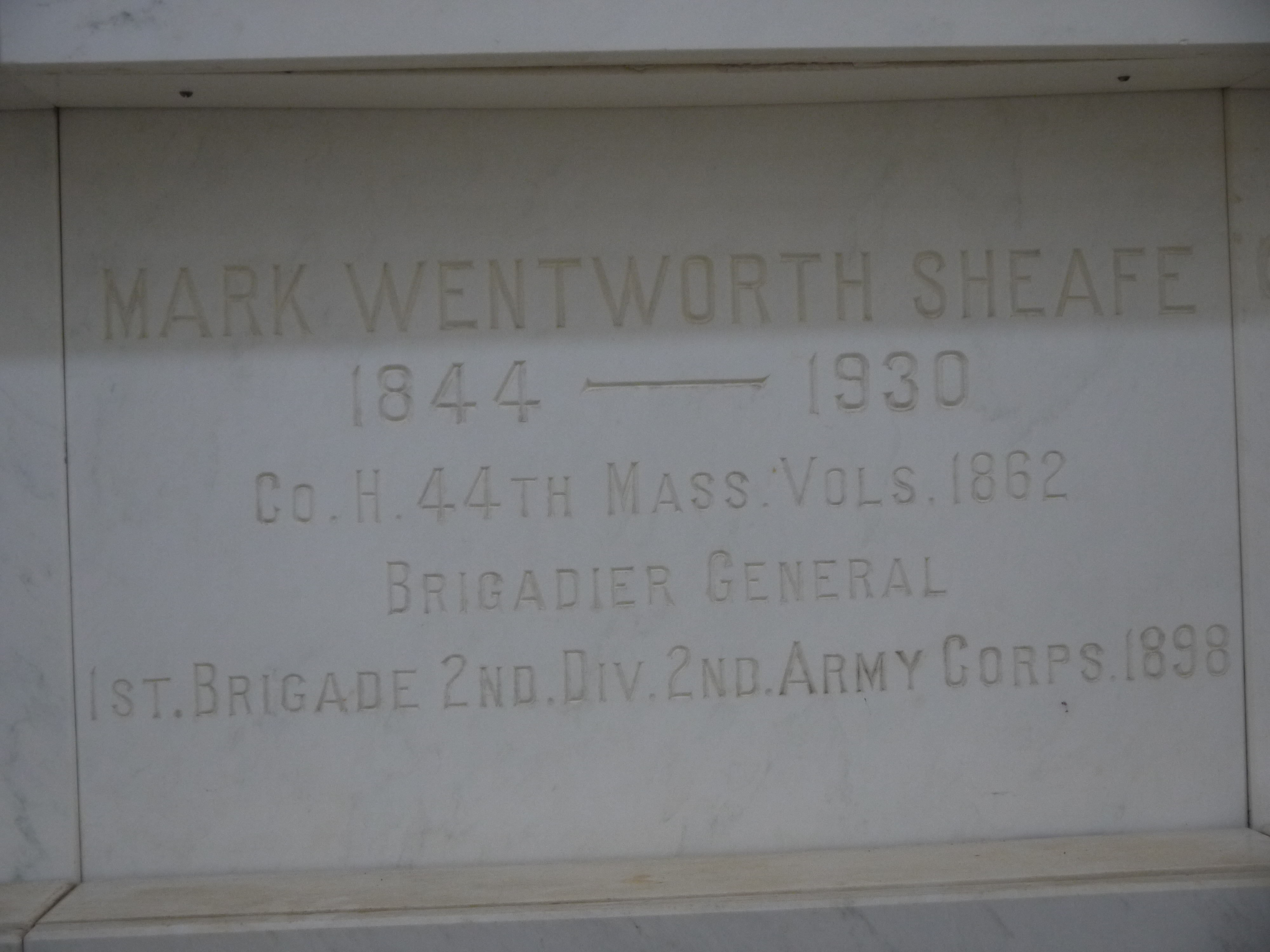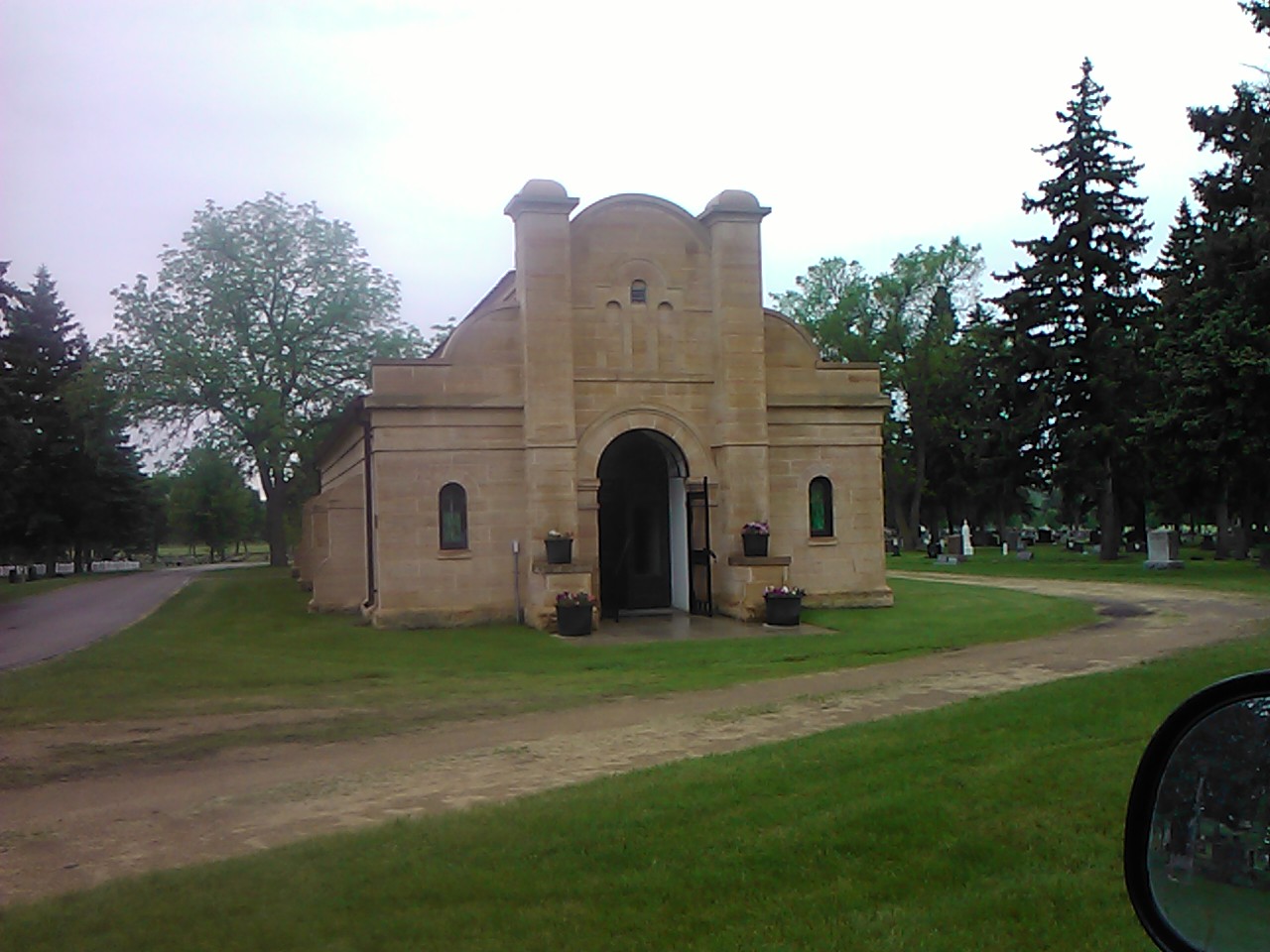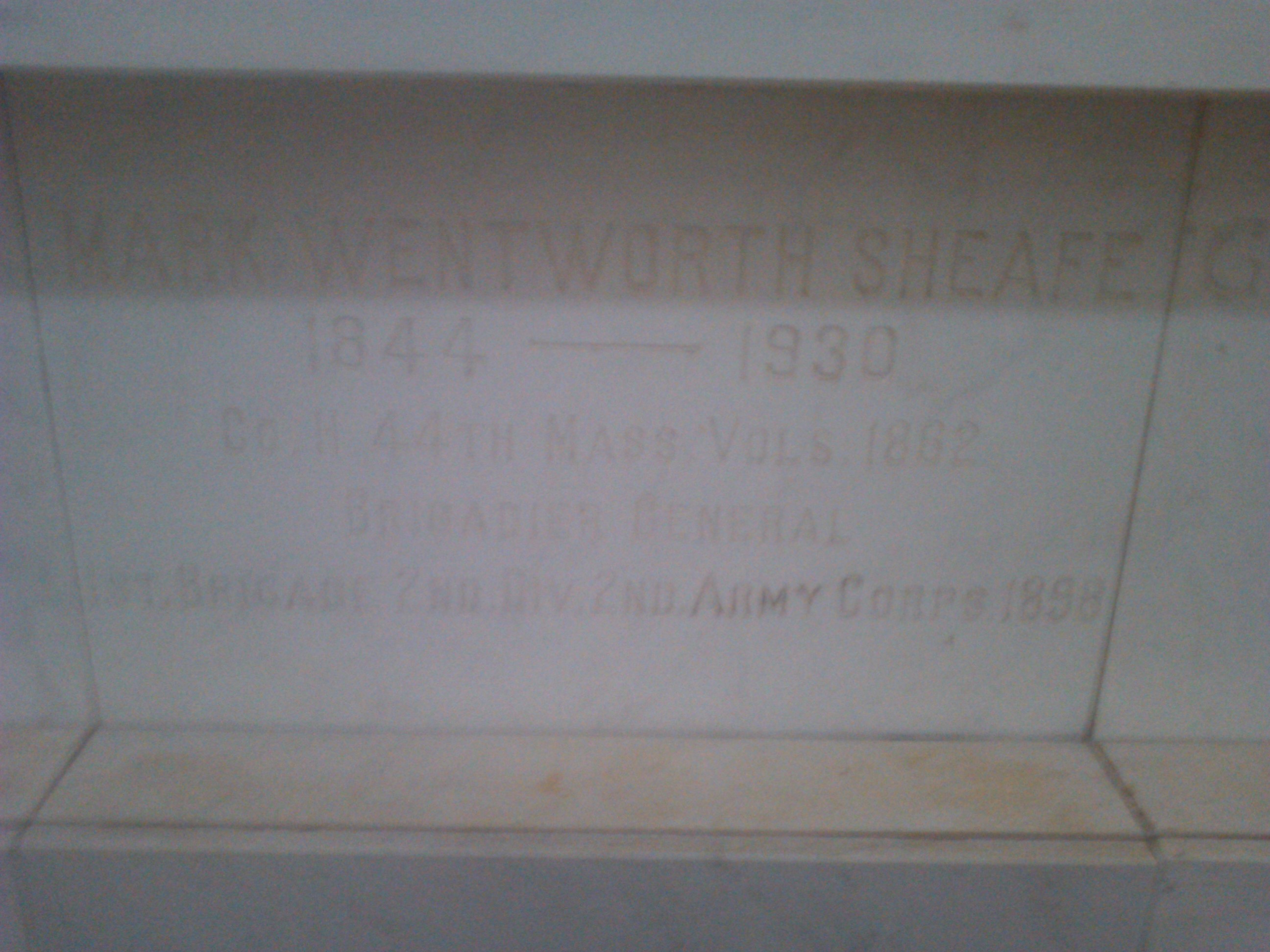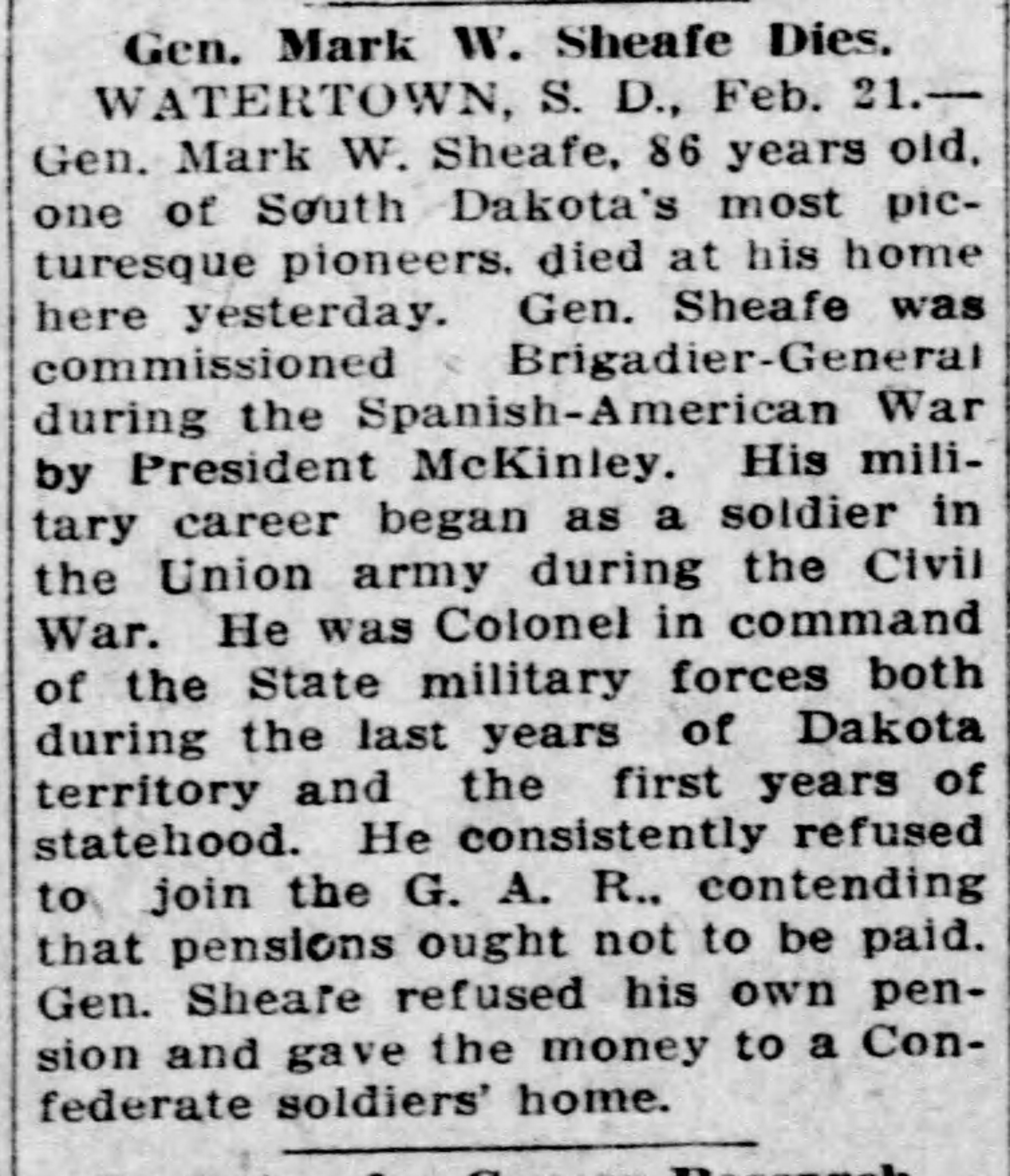A distinguished and honored citizen of South Dakota is General Mark Wentworth Sheafe, of Watertown, who was identified with the pioneer development of the territory and has as well been a factor in the upbuilding of the state. He was born May I8, 1844, in Brooklyn, New York, and in the paternal line is descended from one of the oldest English families, the name of Wentworth being not unknown in English history and at the same time appearing frequently on the pages of America's annals. The lineage can be traced back to the year 1066, before the time of the Norman conquest. The records have been carefully preserved and proven and many men of distinction in England have borne the name of Went worth, which is still known there. The name of Sheafe originated in Cranebroke, Kent England, in 1520, and the family history has been preserved from that time to the present. John Wentworth. an ancestor of General Sheafe, was the last royal governor of New Hampshire in 1775. His father, Governor Benning Wentworth, was mentioned by Longfellow in his poem entitled "Tales of a Wayside Inn." The son of Governor Wentworth was one of the signers of the original Articles of Confederation in 1778, representing the colony of New Hampshire.
In the maternal line General Sheafe is also descended from good old colonial stock, having emigrated from England to Massachusetts in 1646. The family during the Revolutionary war owned Bunker Hill at Charlestown, where, but for a mistake, the battle of that name would have been fought. In that battle were two great-grandfathers of General Sheafe and the records show that the family have participated in every war waged by this country from the first Indian war "King Philip's" down to the Spanish-American war.
General Sheafe passed his boyhood and youth in Boston, acquiring a liberal education for those days, and at the age of seventeen was examined for and prepared to enter Harvard College. However, the Civil war had just begun and, fired with enthusiasm, he, with a number of his fellow students and friends, enlisted in the Forty-fourth Regiment of Massachusetts Volunteers, becoming members of Company H, with which he went to the front. On the expiration of his term of service he accompanied his father to Janesville, Wisconsin, where he entered the First National Bank. While there residing he was married in 1866 to Miss Cassa A. Hall, by whom he had three children.
In 1871 General Sheafe was desirous of going to the frontier and Dakota territory seemed to him a promising field for endeavor and energy. Accordingly in the fall of that year he removed lo Elk Point, Union county, where he became extensively engaged in a lumber business and also in milling. It is a strange coincidence that he should have been the first to ship freight by rail into the territory, and in connection with his large flouring mills he was the first in the territory to adopt the roller process, discarding the old-time millstones. While conducting private business interests he was always more or less prominently connected with public interests and activities and thus aided in shaping the history of county and state along various lines. In 1877 he was selected by Governor Pennington to accompany Colonel, later General, F. D. Grant on a trip into the Indian country with s view of establishing a trail between the Missouri river at Fort Pierre and the Black Hills.
The Indians were restive and somewhat hostile but the trip was made in company with four other parties and its object successfully accomplished, the old Black Hills trail being adopted. In 1881 General Sheafe witnessed the great flood of the Missouri river bottom when the city of Vermillion was completely wiped out and the fertile river valley was ten feet under water. At that time he lent his endeavors to saving the lives of settlers and was himself reported drowned. In fact he had the doubtful pleasure of reading his own obituary as printed in the Sioux City Journal, but apologies were duly made to the public.
In 1882 General Sheafe married Miss Agnes Spark, a native of Edinburgh, Scotland, and to them two children were born, Mark Wentworth and Mary Agnes. The former is a prominent lawyer of Codington county and has been twice elected as state's attorney.
In 1885 General Sheafe was appointed register of the United States land office at Watertown under President Cleveland and removed to the city which is now his home. In that year he also received at the hands of Governor G. A. Pierce the commission as colonel of the Second Regiment, Dakota National Guard, with instructions to perfect the organization of the regiment, which he did. serving as colonel commanding for fifteen years with great success. In 1893 he was again appointed register of the United States land office at Watertown, which position he filled until April, 1897. In the meantime he continued the successful management of his business affairs and broadened the scope of his activities. In 1890 he was elected president of the Dakota Loan & Trust Company, a financial institution for making loans on real estate, the stock of which was owned in New England. Crop failures and a low ebb in financial matters throughout the west compelled the liquidation of this corporation, with but slight loss, however, to its stockholders and clients.
In 1898, at the time the war was declared against Spain by the United States, Colonel Sheafe prepared his regiment for active service and it was one of the first ready for the front. The First South Dakota Regiment made a record second to none. At this time Colonel Sheafe was appointed brigadier general of the United States volunteers by President McKinley and was ordered to report for duty with his brigade, which consisted of the Third New York. Twenty-second Kansas and One Hundred and Fifty-ninth Indiana Regiments. In command of his brigade he gained great credit and the love of his officers and men. The war ending, he asked to be relieved of his command and returned to civil life, assuming again the management of his business affairs. He was for many years largely engaged in handling range cattle on the then uninhabited plains west of the Missouri river and looks back upon the free life with the cowboys, among the wild Texas steer and the bronchos with great pleasure, especially so from the fact that they have both been legislated out of existence in the northwest.
General Sheafe was six times elected mayor of Elk Point and was also elected to the territorial senate in 1874, being today almost the only survivor of that body. In 1890 he was elected to the second state legislative assembly as senator from Codington county and served with credit to himself and honor to his constituents. In 1876 he was selected as territorial delegate to the democratic national convention at St. Louis. In 1897 General Sheafe represented the state of South Dakota at the inauguration of William McKinley to the presidency and was assigned for duty with a mounted troop, acting as bodyguard to the president. In 1913 he was selected to represent the state at the inauguration of President Wiison and on that occasion acted as aid to the grand marshal. In politics General Sheafe is an old-time Jeffersonian-Jacksonian democrat, with all the honor that the name implies. His religious creed is that of the Protestant Episcopal church, of which his forefathers had been adherents for over four hundred years. He is connected with the Masonic fraternity, having had the higher degrees conferred upon him. He is also a member of the Benevolent Protective Order of Elks and regards that organization as one doing much good in the world. He likewise holds membership with the Sons of the American Revolution and the Military Order of Foreign Wars of the United States. General Sheafe has had a varied experience. Descended from an old distinguished family of Massachusetts and New Hampshire, distinguished both in civil and military connections, he yearned for the freedom and simple life of the far west- As a soldier in the Civil and Spanish-American wars he received praise and as a government official he has done his full duty; as a lawmaker his record is good and as a business man he has ever been known for his probity. He has seen the territory which he loved and which contained a total of twenty thousand white inhabitants in 1871, blossom and bring forth two noble states. He has witnessed the passing of the buffalo, the antelope and the cowboy. He has seen his own beloved state, South Dakota, spring up from a few organized counties on the Missouri river and become a grand sovereign commonwealth, rich in soil and resources and equally rich in its acquired advantages. He has lent the best endeavors of his best days to helping bring about this result, and when the last call is made and "taps" are sounded over his body, his wish is that it may rest in the bosom of this state, his home.
- ["History of Dakota Territory", George W. Kingsbury, 1915]
Contributor: Graveyard Queen (48695480)
Married July 18th 1867 to Cassa Hall. Rock county Wisconsin. First child, Mary, May 1868, passed away after 4 months Sept 1868 and is buried in Maple Hill Cemetery, Evansville Wisconsin. First wife of Mark (Cassa) is buried in Oakwood Cemetery Beloit Wisconsin.
Contributor: Aspire (46875813) •
A distinguished and honored citizen of South Dakota is General Mark Wentworth Sheafe, of Watertown, who was identified with the pioneer development of the territory and has as well been a factor in the upbuilding of the state. He was born May I8, 1844, in Brooklyn, New York, and in the paternal line is descended from one of the oldest English families, the name of Wentworth being not unknown in English history and at the same time appearing frequently on the pages of America's annals. The lineage can be traced back to the year 1066, before the time of the Norman conquest. The records have been carefully preserved and proven and many men of distinction in England have borne the name of Went worth, which is still known there. The name of Sheafe originated in Cranebroke, Kent England, in 1520, and the family history has been preserved from that time to the present. John Wentworth. an ancestor of General Sheafe, was the last royal governor of New Hampshire in 1775. His father, Governor Benning Wentworth, was mentioned by Longfellow in his poem entitled "Tales of a Wayside Inn." The son of Governor Wentworth was one of the signers of the original Articles of Confederation in 1778, representing the colony of New Hampshire.
In the maternal line General Sheafe is also descended from good old colonial stock, having emigrated from England to Massachusetts in 1646. The family during the Revolutionary war owned Bunker Hill at Charlestown, where, but for a mistake, the battle of that name would have been fought. In that battle were two great-grandfathers of General Sheafe and the records show that the family have participated in every war waged by this country from the first Indian war "King Philip's" down to the Spanish-American war.
General Sheafe passed his boyhood and youth in Boston, acquiring a liberal education for those days, and at the age of seventeen was examined for and prepared to enter Harvard College. However, the Civil war had just begun and, fired with enthusiasm, he, with a number of his fellow students and friends, enlisted in the Forty-fourth Regiment of Massachusetts Volunteers, becoming members of Company H, with which he went to the front. On the expiration of his term of service he accompanied his father to Janesville, Wisconsin, where he entered the First National Bank. While there residing he was married in 1866 to Miss Cassa A. Hall, by whom he had three children.
In 1871 General Sheafe was desirous of going to the frontier and Dakota territory seemed to him a promising field for endeavor and energy. Accordingly in the fall of that year he removed lo Elk Point, Union county, where he became extensively engaged in a lumber business and also in milling. It is a strange coincidence that he should have been the first to ship freight by rail into the territory, and in connection with his large flouring mills he was the first in the territory to adopt the roller process, discarding the old-time millstones. While conducting private business interests he was always more or less prominently connected with public interests and activities and thus aided in shaping the history of county and state along various lines. In 1877 he was selected by Governor Pennington to accompany Colonel, later General, F. D. Grant on a trip into the Indian country with s view of establishing a trail between the Missouri river at Fort Pierre and the Black Hills.
The Indians were restive and somewhat hostile but the trip was made in company with four other parties and its object successfully accomplished, the old Black Hills trail being adopted. In 1881 General Sheafe witnessed the great flood of the Missouri river bottom when the city of Vermillion was completely wiped out and the fertile river valley was ten feet under water. At that time he lent his endeavors to saving the lives of settlers and was himself reported drowned. In fact he had the doubtful pleasure of reading his own obituary as printed in the Sioux City Journal, but apologies were duly made to the public.
In 1882 General Sheafe married Miss Agnes Spark, a native of Edinburgh, Scotland, and to them two children were born, Mark Wentworth and Mary Agnes. The former is a prominent lawyer of Codington county and has been twice elected as state's attorney.
In 1885 General Sheafe was appointed register of the United States land office at Watertown under President Cleveland and removed to the city which is now his home. In that year he also received at the hands of Governor G. A. Pierce the commission as colonel of the Second Regiment, Dakota National Guard, with instructions to perfect the organization of the regiment, which he did. serving as colonel commanding for fifteen years with great success. In 1893 he was again appointed register of the United States land office at Watertown, which position he filled until April, 1897. In the meantime he continued the successful management of his business affairs and broadened the scope of his activities. In 1890 he was elected president of the Dakota Loan & Trust Company, a financial institution for making loans on real estate, the stock of which was owned in New England. Crop failures and a low ebb in financial matters throughout the west compelled the liquidation of this corporation, with but slight loss, however, to its stockholders and clients.
In 1898, at the time the war was declared against Spain by the United States, Colonel Sheafe prepared his regiment for active service and it was one of the first ready for the front. The First South Dakota Regiment made a record second to none. At this time Colonel Sheafe was appointed brigadier general of the United States volunteers by President McKinley and was ordered to report for duty with his brigade, which consisted of the Third New York. Twenty-second Kansas and One Hundred and Fifty-ninth Indiana Regiments. In command of his brigade he gained great credit and the love of his officers and men. The war ending, he asked to be relieved of his command and returned to civil life, assuming again the management of his business affairs. He was for many years largely engaged in handling range cattle on the then uninhabited plains west of the Missouri river and looks back upon the free life with the cowboys, among the wild Texas steer and the bronchos with great pleasure, especially so from the fact that they have both been legislated out of existence in the northwest.
General Sheafe was six times elected mayor of Elk Point and was also elected to the territorial senate in 1874, being today almost the only survivor of that body. In 1890 he was elected to the second state legislative assembly as senator from Codington county and served with credit to himself and honor to his constituents. In 1876 he was selected as territorial delegate to the democratic national convention at St. Louis. In 1897 General Sheafe represented the state of South Dakota at the inauguration of William McKinley to the presidency and was assigned for duty with a mounted troop, acting as bodyguard to the president. In 1913 he was selected to represent the state at the inauguration of President Wiison and on that occasion acted as aid to the grand marshal. In politics General Sheafe is an old-time Jeffersonian-Jacksonian democrat, with all the honor that the name implies. His religious creed is that of the Protestant Episcopal church, of which his forefathers had been adherents for over four hundred years. He is connected with the Masonic fraternity, having had the higher degrees conferred upon him. He is also a member of the Benevolent Protective Order of Elks and regards that organization as one doing much good in the world. He likewise holds membership with the Sons of the American Revolution and the Military Order of Foreign Wars of the United States. General Sheafe has had a varied experience. Descended from an old distinguished family of Massachusetts and New Hampshire, distinguished both in civil and military connections, he yearned for the freedom and simple life of the far west- As a soldier in the Civil and Spanish-American wars he received praise and as a government official he has done his full duty; as a lawmaker his record is good and as a business man he has ever been known for his probity. He has seen the territory which he loved and which contained a total of twenty thousand white inhabitants in 1871, blossom and bring forth two noble states. He has witnessed the passing of the buffalo, the antelope and the cowboy. He has seen his own beloved state, South Dakota, spring up from a few organized counties on the Missouri river and become a grand sovereign commonwealth, rich in soil and resources and equally rich in its acquired advantages. He has lent the best endeavors of his best days to helping bring about this result, and when the last call is made and "taps" are sounded over his body, his wish is that it may rest in the bosom of this state, his home.
- ["History of Dakota Territory", George W. Kingsbury, 1915]
Contributor: Graveyard Queen (48695480)
Married July 18th 1867 to Cassa Hall. Rock county Wisconsin. First child, Mary, May 1868, passed away after 4 months Sept 1868 and is buried in Maple Hill Cemetery, Evansville Wisconsin. First wife of Mark (Cassa) is buried in Oakwood Cemetery Beloit Wisconsin.
Contributor: Aspire (46875813) •
Gravesite Details
Co. H 44 Mass Vol.
Family Members
Sponsored by Ancestry
Advertisement
Advertisement
